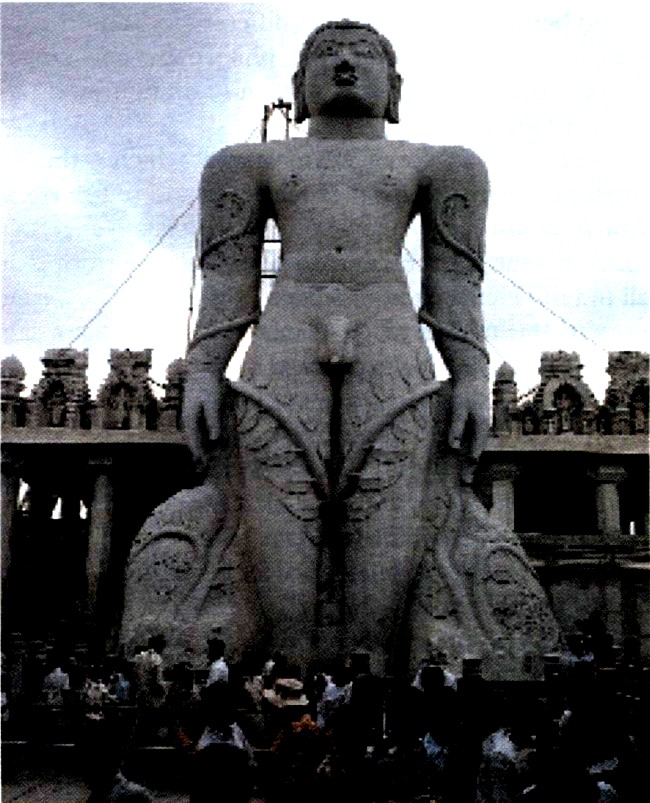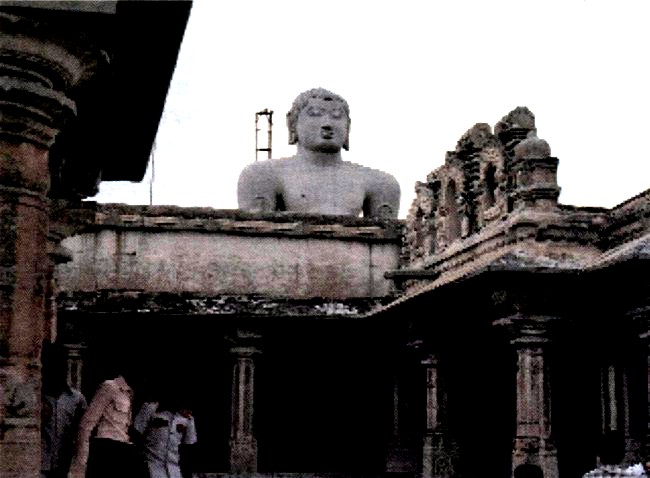Kenneth Oldfield writes about his pilgrimage to this famous Jain tirtha.
 The local bus from Bangalore to Hassan in South Karnataka will drop you off between two hills that enclose the litde town of Shravana Belgola. It's much better to stay a few days reflecting and meditating here than take the tourist day-trip which allows you barely an hour to chase up the two hills and return to the bus to press on to the temples near Hassan, so that you can be back in Bangalore for dinner. There are a couple of inexpensive Jain guest houses, mainly empty when I was there in late October - just the right time of year, if you plan to climb the hills regularly.
The local bus from Bangalore to Hassan in South Karnataka will drop you off between two hills that enclose the litde town of Shravana Belgola. It's much better to stay a few days reflecting and meditating here than take the tourist day-trip which allows you barely an hour to chase up the two hills and return to the bus to press on to the temples near Hassan, so that you can be back in Bangalore for dinner. There are a couple of inexpensive Jain guest houses, mainly empty when I was there in late October - just the right time of year, if you plan to climb the hills regularly.
Shravana Belgola is the major Jain tirtha or pilgrimage centre in South India. A tirtha is a crossing over point, perhaps a ford across a river or a crossroads, which in the Indian religious traditions has come to take on far deeper spiritual meaning. It signifies a place where the earthly and heavenly may meet, and the possibility of a crossing over may be a reality. Such places are centres of pilgrimage throughout India. Shravana Belgola attracts Jains of all sects and tourists from all nations not just because it has the largest colossus in India or the greatest concentration of Digambara Jain temples in any single place. Its beauty, physical geography, myth, history and architecture all combine to create a tangible holiness which has enabled Jains throughout the ages to invite death (as opposed to fearing it) and in so doing, celebrate some of the greatest values in life.
The very name of the place derives from its Jain associations that date back at least to the 3rd century BC. Shravana is the Sanskrit word for a Jain sadhu and Belgola comes from two Kannada names 'bel' meaning white, and 'kola' (gola) meaning pond, which describes the beautiful tank which lies between the two hills enclosing this bright sacred place. The two hills of Vindhyagiri and Chandragiri carry history in their meaning too. 'Giri' means hill, and Vindhyagiri is composed of two words 'Vim' meaning soul and 'dhya' meaning meditation, thus giving 'hill for the meditation of soul'. It is on top of this hill that the colossus of Bahubali has stood for a thousand years in deep meditation.
Chandragiri, the hill of Chandragupta, recalls some of the legendary Jain history which tells how the first Indian Emperor, Chandragupta joined Jain ascetics on this hill for the last years of his life before dying according to the Jain rite of Sallekhana. It is said that his more famous grandson, Ashoka visited the hill to pay respect to his departed grandfather and actually named the place Shravana Belgola.
Both hills today require time if a visit is to prove rewarding. Chandragiri, the smaller of the two hills, has the most ancient history and over the centuries has been the hill to which Jain self-mortifiers have retreated. Early estimates suggest that as many as seven hundred pious Jains had invited death voluntarily among these rocks by the end of the 7th century. From this time onwards, inscriptions in the rock of the hillside tell of those who took the rite of Sallekhana and these inscriptions offer tremendous evidence to historians about the activities on this sacred hill. Today you will find more than 20 temples, a pillar and a cave to add to the history the inscriptions relate. You need a guide or a guidebook to fit the history together meaningfully during a short visit.
 It is the larger hill however, to which most pilgrims go these days. The steep rugged climb up to the great colossus of Bahubali is demanding in the heat of the day and it serves to remind you of the limitations of your own body. The thousand year old, fifty seven foot high granite carving, consecrated in 981 AD, assures you of the power of the human form to transcend physical weakness, to reach towards higher goals still. Gommateshvara (Lord of the Hillock), as the statue is popularly known, represent Bahubali, son of the first tirthankara, Adinatha. After defeating his brother Bharata in battle, he renounced the world seeking enlightenment.
It is the larger hill however, to which most pilgrims go these days. The steep rugged climb up to the great colossus of Bahubali is demanding in the heat of the day and it serves to remind you of the limitations of your own body. The thousand year old, fifty seven foot high granite carving, consecrated in 981 AD, assures you of the power of the human form to transcend physical weakness, to reach towards higher goals still. Gommateshvara (Lord of the Hillock), as the statue is popularly known, represent Bahubali, son of the first tirthankara, Adinatha. After defeating his brother Bharata in battle, he renounced the world seeking enlightenment.
He stood nude in the characteristically Jain kayotsarga posture for over a year so that creepers and anthills grew around his legs. Despite this severe penance, Bahubali did not attain liberation. His two sisters asked their tirthankara father, Adinatha the cause of impediment to their brother. They learned that Bahubali still harboured resentment because he was standing on his brother's land. The sisters pulled away the creepers that had grown around their brother and whispered, 'Dismount from the elephant, Revered Brother!' When Bahubali's brother came to pay homage to Bahubali, the act of the affection and humility unlocked Bahubali's pride and he dismounted the elephant, and the path to moksha became possible.
Thousands of pilgrims of all religions visit Bahubali today. A group of young Keralan Christian students visited whilst I was there. 'What is this great statue saying to us and the world today?' I asked.
'Is this Jain stillness, renunciation and meditation compatible with your Christian values?' But there was no serious reply. 'We're only here on holiday,' they said, 'Nothing more. We come but to enjoy' But not all the visitors are tourists. Climbing up very early one morning hoping to see the sun rise above the early morning mist, I witnessed a most powerful colossus in water, milk, coconut milk, sandalwood paste and haldi powder. Hindus, Jains and Christians alike rushed to receive the scattered holy liquid and reach towards the stillness and powet that Bahubali embodies.
Shravana Belgola is very much alive with Jain values today. H.H. Charukeerty Bhatarak Swamiji presides over major social and education programmes based in the little town. In a school for novitiates I met 36 young men from Karnataka and Tamil Nadu, who are studying in preparation for taking their vows. A unique historic library of Jain books is housed in the town, carefully guarded by expert keepers. A mobile hospital operates from Shravana Belgola serving the needs of the poor in the surrounding villages. I thoroughly recommend anvone to visit this auspicious site.
The late Ken Oldfield was author of 'Jainism, the Path of Purity and Peace'. He was a dedicated promoter of Jainism, spending some years in Rajasthan as a Teacher with the Voluntary Service Overseas.
 Kenneth Oldfield
Kenneth Oldfield
